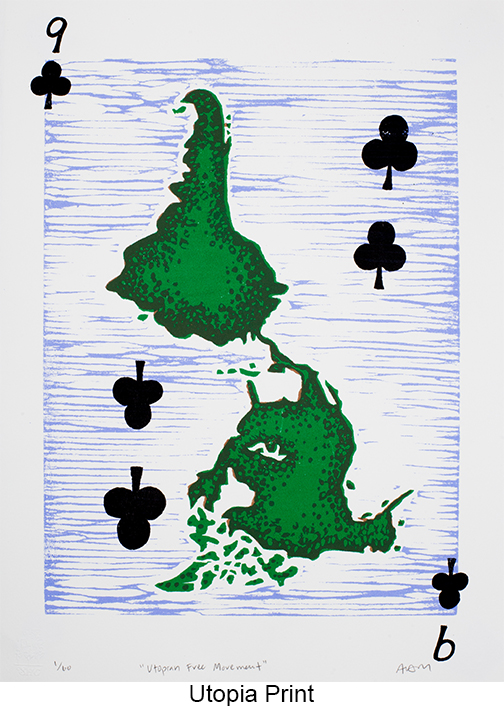Álvaro D. Márquez, Utopia and Dystopia, 2019


Álvaro D. Márquez, Utopia and Dystopia, 2019
Álvaro D. Márquez
Utopian Free Movement and Dystopian Borders (diptych), 2019
Serigraph, ed. 60
15”x11” - each
From the Utopia/Dystopia Portfolio Project
Individual print: $250
Pair of prints: $400
Álvaro D. Márquez’s Utopian Free Movement and Dystopian Borders were created in part of the “Utopia/Dystopia” portfolio, curated by artist Miyo Stevens-Gandara. Miyo invited 26 artists to each pick two cards from a full deck, incorporating a diverse range of interpretations and ideas into a single, unified collection.
In his dystopian print, Márquez presents a typical representation of the map of the Americas, showing the borders that were drawn out and imposed on the Americas as a result of colonial and imperial forces. His use of red and orange symbolize ecological devastation caused by modernization and extractive economies dating back to the moment of colonization. By contrast, Márquez inverts the Americas, and offers a borderless, fluid entity as a representation of utopia. He sources Joaquin Torres García’s “Inverted America” illustration, which destabilizes the established inferiority of South America and the “Global South” relative to the North.
As a native of East Salinas, California, Márquez was raised in a community of migrant farmers and members of the working class. His work examines the intersection of channel social, racial, and gender inequality. He aims to challenge the gap between “low brow” and “high art”-- distinctions that arise from structural inequities through space and time. Specifically, he bridges these categorical differentiations by drawing inspiration from comic books and visual storytelling.
Márquez received his B.A. in History from Brown University, followed by his M.A. with an emphasis in Visual Studies from the University of Southern California. In the Fall of 2017, Alvaro also began his candidacy for his M.F.A. in Art with an emphasis in Printmaking at California State University. Living and working at present in Los Angeles, he works as a visual artist as well as a part-time professor of Chicana/o and Latina/o Studies at California State University, Los Angeles.
